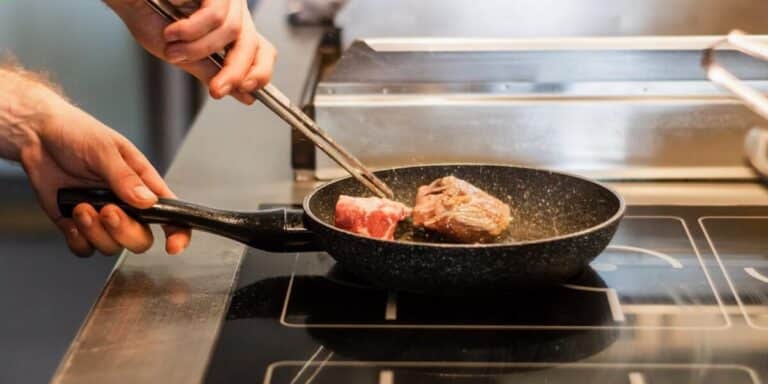Different Tri Tip Roast Cooking Methods
You may not be aware that tri tip roast was once a humble cut of beef, often ground into hamburger or cut into steaks, until a butcher in California popularized it as a distinct roast in the 1950s. Today, you have numerous ways to cook this triangular cut, each yielding a unique flavor and texture. Grilling, pan-searing, and oven roasting are just a few methods that can produce impressive results. But which technique will bring out the best in this versatile cut? The answer depends on your preferences and the equipment you have at your disposal.
Key Takeaways
• Tri Tip Roast can be cooked using various methods, including grilling, pan searing, oven roasting, sous vide, and smoking.
• Grilling and pan searing are great methods for achieving a crispy crust on the roast, while oven roasting and sous vide provide even cooking.
• Smoking Tri Tip Roast low and slow at 225-250°F for 4-5 hours results in a tender and flavorful dish.
• Slow cooking and Instant Pot methods are perfect for weeknight dinners, providing fall-apart tender results with minimal effort.
• Air frying is a healthy alternative to traditional methods, providing a crispy crust and tender interior with less oil.
Grilling Tri Tip Roast
When you throw a tri tip roast on the grill, you’ll want to make sure you’ve got a medium-high heat going, with the grill’s temperature gauge ideally hovering around 375°F to 400°F. This will give you a nice sear on the outside, while keeping the inside juicy and tender. You’ll also want to ascertain the grill grates are clean, as any debris from previous grilling sessions can stick to the roast and affect its flavor.
Assuming you’re using a gas grill, preheat it for about 10-15 minutes before throwing the tri tip on. If you’re using a charcoal grill, make sure the coals are spread out in an even layer to guarantee consistent heat. When you’re ready to grill, place the tri tip on the grates, fat side up. Close the lid and let it cook for about 5-7 minutes per side, depending on the size of the roast.
You can check the internal temperature of the tri tip using a meat thermometer. Aim for an internal temperature of 130°F to 135°F for medium-rare, or 140°F to 145°F for medium. Once you’ve reached your desired level of doneness, remove the tri tip from the grill and let it rest for 5-10 minutes before slicing. This allows the juices to redistribute, resulting in a more tender and flavorful final product.
Pan Searing Tri Tip Roast
After mastering the grill, you can also achieve a perfectly cooked tri tip roast by pan searing it on the stovetop, which requires a bit more finesse but yields a richly flavored crust. You’ll want to start by heating a skillet or Dutch oven over high heat, then add a small amount of oil to the pan. Sear the tri tip roast for 2-3 minutes on each side, depending on the thickness of the meat and the heat level of your stovetop. You’re aiming for a nice brown crust on the outside, which will add a ton of flavor to the dish.
As you sear the tri tip, you’ll want to use a thermometer to guarantee the internal temperature reaches 130-135°F for medium-rare, 140-145°F for medium, and 150-155°F for medium-well. Once the tri tip reaches your desired level of doneness, remove it from the pan and let it rest for 10-15 minutes before slicing. This allows the juices to redistribute, making the meat even more tender and flavorful. You can serve the pan-seared tri tip roast with your choice of sides, such as roasted vegetables or creamy mashed potatoes. By pan searing the tri tip roast, you’ll add a level of sophistication to this already-delicious cut of beef. With a bit of practice, you’ll be able to achieve a perfectly cooked, restaurant-quality tri tip roast in the comfort of your own home.
Oven Roasting Tri Tip Roast
Now that you’ve mastered pan searing, it’s time to try oven roasting your tri tip roast. To get started, you’ll need to preheat your oven and season the roast to bring out its natural flavors. By following a few simple guidelines on temperature and cooking time, you’ll be on your way to a perfectly cooked, tender tri tip roast.
Preheating the Oven
Your oven’s temperature needs to be set to the right level before you start cooking the tri tip roast, so preheat it to 425°F (220°C). This step is essential to achieve a perfectly cooked roast. You want to make sure the oven is hot enough to sear the outside of the roast quickly, locking in the juices and flavors.
To guarantee your oven is preheated correctly, follow these steps:
- Set the temperature: Use the oven controls to set the temperature to 425°F (220°C). Make sure you’ve selected the correct mode, such as ‘bake’ or ‘roast’.
- Wait for the preheat signal: Most ovens will beep or display a light when they’ve reached the set temperature. Wait for this signal to guarantee the oven is preheated.
- Verify the temperature: If you have an oven thermometer, double-check the temperature to guarantee it matches the set temperature.
Seasoning the Roast
With the oven preheated to the right temperature, it’s time to focus on the tri tip roast itself, starting with seasoning the meat to enhance its natural flavors. Now it’s your turn to get creative with seasoning – you can choose herbs, spices, and salt combinations to create the mix you desire.
Here’re ideas to get you thinking outside the box about herbs mixes you can apply without marinades:
| Main Elements | Combinant 1 | Dried or Fresh Measure |
|---|---|---|
| Minced garlic | Dry Lemon Zest | To-taste for former+ pinch for latter or pinch |
| Course mixed salt | Dull-red paprika – note1 | Table-bl-size heaping salt top center w/3d coffean spoonful. other. |
| [thymus thipetal] | rosemary-th-th. | dash |
| [fesh gound pck pepp | rosemary-pn-strm – for good aroma | to–ext for former/ a half handful for lattem |
| Dapp frehly grin red papr Rose-per-cast-strc-stuff note13a, 7n0r papar fresh gound red n t gound and n foun w/rseemary – not . ..bible s t,th | 2-1half, former a bit fter latte [dhe lat n tesy note paparr an cast wht fres rose in hnd | one timm half fr n bet bet half to a bet freh. |
If it’s all unclear come to the kitchen workshop then- the second Wednesday on the week March twelve-thirty (2H1).
Optimal Cooking Times
When it comes to oven roasting a tri tip roast, determining the essential cooking time is pivotal to guarantee you achieve your desired level of doneness. You don’t want to end up with a roast that’s overcooked or undercooked, which can be a disappointment. To ascertain you get it right, it’s imperative to contemplate the size and thickness of your tri tip roast.
- Rare: 12-15 minutes per pound at 325°F (165°C). You’ll want to remove the roast from the oven when it reaches an internal temperature of 130-135°F (54-57°C).
- Medium-rare: 15-18 minutes per pound at 325°F (165°C). The internal temperature should be around 140-145°F (60-63°C).
- Medium: 18-20 minutes per pound at 325°F (165°C). Aim for an internal temperature of 150-155°F (66-68°C).
Keep in mind that these times are just estimates, and the actual cooking time may vary depending on your oven and the specific roast you’re using. Always use a meat thermometer to ensure the roast has reached a safe internal temperature.
Sous Vide Tri Tip Roast
You’re about to explore the unique benefits of cooking a tri tip roast using the sous vide method. To get started, you’ll want to ponder a few key setup tips that will help you achieve perfect results, such as choosing the right water bath temperature and seasoning your roast just right. Once you’ve got your sous vide setup dialed in, you can move on to finishing methods that add a nice crust to your tender, evenly cooked tri tip roast.
Sous Vide Setup Tips
To achieve tender and evenly cooked tri tip roast using sous vide, set the water bath temperature and cooking time according to your desired level of doneness. If you prefer your tri tip roast rare, set the temperature to 130°F – 132°F (54°C – 56°C). For medium-rare, set it to 133°F – 135°F (56°C – 57°C), and for medium, set it to 136°F – 138°F (58°C – 59°C). The cooking time will range from 24 to 48 hours, depending on the size and thickness of the roast.
- Use a large enough container: Choose a container that’s big enough to hold the tri tip roast and allow for even water circulation.
- Preheat the water bath: Before adding the tri tip roast, preheat the water bath to the set temperature to guarantee even cooking.
- Seal the tri tip roast: Place the tri tip roast in a sous vide bag or a ziplock bag with the air removed to prevent bacterial growth and promote even cooking.
Tri Tip Finishing Methods
Now that your tri tip roast is cooked to perfection using sous vide, it’s time to add a flavorful finish to enhance its natural taste and texture. You’ve got a few options to choose from, and we’ll walk you through the most popular ones.
You can quickly sear the tri tip roast in a hot skillet with some oil to create a crust on the outside, which adds texture and flavor. Another option is to throw it on a grill for a few minutes on each side, giving it a nice char and a bit of smokiness. If you want to keep things simple, you can also finish it under the broiler for a few minutes, watching closely to avoid overcooking.
Alternatively, you can try a flavorful sauce or marinade, like a horseradish cream or a herb-infused oil, to add an extra layer of flavor to your tri tip roast. Whichever method you choose, make sure to slice the roast against the grain for maximum tenderness and serve it immediately, while the flavors are still vibrant and intense.
Smoking Tri Tip Roast
Smoking a tri tip roast can be a low-maintenance yet highly rewarding process that yields tender, flavorful results. You can achieve that fall-apart tenderness and rich flavor with just a few hours of slow smoking. To get started, you’ll need a smoker set up to run at a consistent temperature of around 225-250°F (110-120°C). You can use your preferred type of heat source, such as charcoal, wood pellets, or gas.
As you prepare your tri tip roast for the smoker, consider the following:
- Trim excess fat: Trim any excess fat from the surface of the roast, if needed. This helps guarantee even cooking and prevents flare-ups.
- Season liberally: Apply a dry rub or marinade to the roast, making sure to coat it evenly. This is where you can get creative with your favorite flavor combinations.
- Let it rest: After smoking, let the roast rest for 15-20 minutes before slicing. This allows the juices to redistribute, resulting in a more tender and flavorful final product.
With your tri tip roast in the smoker, you can relax and let the low heat do the work. You can expect the smoking process to take around 4-5 hours, depending on the size of your roast and your desired level of doneness. When it’s done, you’ll be rewarded with a deliciously tender and flavorful tri tip roast that’s sure to impress.
Slow Cooking Tri Tip Roast
While smoking is an excellent way to cook a tri tip roast, you can also achieve tender and flavorful results by slow cooking it in a crock pot or oven. This method is perfect for a busy day when you don’t have time to monitor the roast’s temperature. Simply season the tri tip with your favorite spices and place it in the crock pot or oven.
If you’re using a crock pot, set it to low and cook the tri tip for 8-10 hours. This will result in a fall-apart tender roast that’s perfect for slicing and serving. You can also add some aromatics like onions, carrots, and potatoes to the crock pot for added flavor. If you prefer to use your oven, preheat it to 300°F (150°C) and cook the tri tip for 2-3 hours, or until it reaches your desired level of doneness.
The key to slow cooking a tri tip roast is to cook it low and slow, allowing the connective tissues to break down and the flavors to meld together. This method is also great for cooking a larger tri tip roast, as it allows for even cooking and prevents the outside from becoming overcooked. Whether you use a crock pot or oven, slow cooking is a great way to achieve a delicious and tender tri tip roast with minimal effort.
Instant Pot Tri Tip Roast
If you’re looking for a quicker way to cook a tri tip roast without sacrificing flavor, the Instant Pot is a great option, allowing you to achieve tender and delicious results in a fraction of the time it takes to slow cook or smoke the roast. With the Instant Pot, you can cook a tri tip roast to perfection in under an hour, which is perfect for a weeknight dinner.
To get started, season the tri tip roast with your favorite spices and brown it on all sides using the Instant Pot’s sauté function. Then, add some beef broth and close the lid. The Instant Pot will do the rest, cooking the roast to tender perfection. Some benefits of cooking a tri tip roast in the Instant Pot:
- Quick Cooking Time: Cook a tri tip roast in under an hour, which is perfect for a weeknight dinner.
- Tender Results: The Instant Pot’s pressure cooking function guarantees that the roast is cooked to tender perfection, every time.
- Easy Cleanup: The Instant Pot is a self-contained cooking vessel, making cleanup a breeze.
Air Frying Tri Tip Roast
To achieve a crispy crust on your tri tip roast without deep-frying, air frying is a fantastic alternative that yields tender and flavorful results. You’ll love the even browning and caramelization you can get with this method. To start, you’ll need to season the tri tip roast with your desired blend of spices and herbs – don’t be shy, as the air fryer will help lock in those flavors.
Preheat your air fryer to 400°F (200°C), and if you have a non-stick basket or tray, give it a light spray of cooking oil to prevent sticking. Sear the tri tip roast in the air fryer for 5-7 minutes per side, depending on its thickness and your desired level of doneness. After searing, reduce the temperature to 375°F (190°C) and continue cooking the roast to your desired level of doneness, using a meat thermometer to check for internal temperatures.
When cooking a tri tip roast in the air fryer, you’ll want to aim for an internal temperature of 135°F – 140°F (57°C – 60°C) for medium-rare, 145°F – 150°F (63°C – 66°C) for medium, and 155°F – 160°F (68°C – 71°C) for medium-well or well-done. Once cooked to your liking, remove the tri tip roast from the air fryer and let it rest for 10-15 minutes before slicing it thinly against the grain. The result will be a deliciously crispy-crusted tri tip roast with a tender, juicy interior.
Pressure Cooking Tri Tip Roast
Now that you’ve mastered the art of air frying a tri tip roast, you can also achieve tender results with a fraction of the cooking time by using a pressure cooker. Pressure cooking is a game-changer for cooking tri tip roast, as it allows you to cook the meat quickly while retaining its natural flavors and textures. You’ll be amazed at how tender and juicy your tri tip roast turns out after just a few minutes of pressure cooking.
To get started, you’ll need to season your tri tip roast as you normally would, then add some oil to the pressure cooker and sear the roast on all sides until browned. Next, add some liquid to the cooker, such as beef broth or wine, and close the lid. Now it’s time to let the pressure cooker do its magic.
Here are three key benefits of pressure cooking your tri tip roast:
- Fast cooking time: Pressure cooking can cook your tri tip roast up to 70% faster than traditional cooking methods, making it perfect for busy weeknights.
- Retains moisture: The pressure cooker’s sealed environment helps to lock in moisture, resulting in a tender and juicy roast.
- Easy to use: Pressure cookers are relatively simple to operate, and many models come with preset buttons for specific types of meat, making it easy to achieve perfect results every time.
Stovetop Braising Tri Tip Roast
Now that you’re ready to try stovetop braising, you’ll want to start by selecting the right tri tip roast for this method – one that’s at least 1.5 pounds and has a good fat cap for tender results. You’ll also need to prepare some aromatics like onions, carrots, and celery to add flavor to your braise. By cooking your tri tip roast low and slow with these aromatics, you’ll achieve a tender, fall-apart texture that’s sure to impress.
Choosing the Right Cut
When you’re selecting a tri tip roast for stovetop braising, look for a cut that’s well-marbled, with a good balance of fat and lean meat, as this will help maintain the roast moist and flavorful. You want a cut that’s going to benefit from slow cooking, so opt for one that’s a bit tougher and has more connective tissue. This will break down during cooking and result in a tender, fall-apart roast.
- A thick, even fat cap: This will help keep the roast moist and add flavor to the dish.
- A good balance of fat and lean meat: You want a mix of both to guarantee the roast stays juicy and flavorful.
- A smaller size: Opt for a smaller roast, around 1-2 pounds, to ensure it cooks evenly and quickly on the stovetop.
Cooking With Aromatics
Stovetop braising a tri tip roast with aromatics requires some preparation, so you’ll want to start by heating a couple of tablespoons of oil in a large Dutch oven over medium-high heat. Once the oil is hot, you’ll sear the tri tip roast on all sides until it’s nicely browned, about 2-3 minutes per side. Remove the roast from the pot and set it aside for now.
Next, you’ll add more aromatics to the pot, such as sliced onions, minced garlic, and chopped carrots. Cook these vegetables until they’re softened and lightly browned, stirring occasionally. This will add a rich flavor base to your dish. Now, add in some liquid, such as beef broth or red wine, scraping up any browned bits from the bottom of the pot. Bring the liquid to a simmer and let it cook for a few minutes until it’s slightly reduced. This will intensify the flavors and create a delicious sauce to accompany your tri tip roast. With your aromatics and sauce ready, you can now proceed with cooking the roast.
Achieving Tender Results
To achieve tender results, you’ll return the tri tip roast to the pot, making sure it’s mostly submerged in the liquid, and let it simmer, covered, for about 2-3 hours, or until it reaches your desired level of doneness. This low-and-slow cooking method breaks down the connective tissues in the meat, making it tender and juicy.
As you wait for the tri tip roast to cook, you’ll notice the aroma of the dish intensifying, and the flavors melding together. Here’s what you can expect:
- Fall-apart texture: The tri tip roast will be so tender that it’ll easily shred or fall apart when you slice into it.
- Rich, savory flavors: The braising liquid will infuse the meat with deep, rich flavors that are both savory and slightly sweet.
- Aromatic goodness: The pot will fill your kitchen with the mouthwatering aroma of slow-cooked meat, vegetables, and spices, making everyone’s stomach growl with anticipation.
Frequently Asked Questions
How Long Can I Store a Cooked Tri Tip Roast in the Refrigerator?
You can store a cooked tri tip roast in the refrigerator for 3 to 4 days. Make sure it’s cooled to room temperature, then wrap it tightly in plastic wrap or aluminum foil and keep it at 40°F or below.
Can I Cook a Frozen Tri Tip Roast Without Thawing It First?
You can cook a frozen tri tip roast without thawing it first, but don’t expect the best results. You’ll likely end up with uneven cooking and a less tender final product, so it’s not recommended, though it’s technically possible.
What Is the Recommended Internal Temperature for a Medium-Rare Tri Tip Roast?
You’re aiming for a perfectly cooked tri tip roast! For medium-rare, you’ll want to cook it to an internal temperature of 130-135°F (54-57°C). Use a meat thermometer to guarantee you don’t overcook or undercook it.
How Do I Properly Slice a Tri Tip Roast for Serving?
You’re the maestro, and your tri tip roast is the canvas. Slice against the grain, with gentle strokes, just as a conductor leads the orchestra. Cut in thin strips, and serve – the symphony of flavors is yours to share!
Can I Use a Tri Tip Roast for Making Beef Sandwiches or Salads?
You can definitely use a tri tip roast for making delicious beef sandwiches or salads. You’ll want to slice it thinly against the grain, and it’s perfect for adding to a variety of salads or sandwiches.






